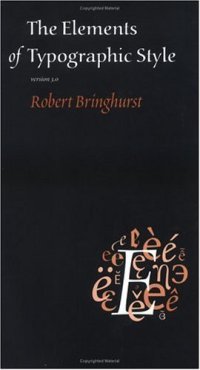
Ebook: The Elements of Typographic Style
Author: Robert Bringhurst
- Genre: Art // Graphic Arts
- Year: 2004
- Publisher: Hartley & Marks
- City: Vancouver
- Edition: 3.0
- Language: English
- pdf
The Elements of Typographic Style is a book by Canadian typographer, poet and translator Robert Bringhurst. Originally published in 1992 by Hartley & Marks Publishers, it was revised in 1996, 2001 (v2.4), 2002 (v2.5), 2004 (v3.0), 2005 (v3.1), 2008 (v3.2), and 2012 (v4.0). A history and guide to typography, it has been praised by Hermann Zapf, who said “I wish to see this book become the Typographers’ Bible.” Jonathan Hoefler and Tobias Frere-Jones consider it “the finest book ever written about typography”, according to the FAQ section of their type foundry’s website. Because of its widespread use, it is sometimes abbreviated simply as Bringhurst.
What accounts for the lasting influence and popularity of Bringhurst’s book? There are three reasons: the range and depth of his treatment, the quality of his writing, and the confidence and generosity of his tone.
Bringhurst’s scope is wide: the fundamentals and finer points of macro- and micro typography, type anatomy and classification; choosing typefaces and page formats; the use of diacritics and other analphabetic symbols (no doubt his experience as a translator of languages that rely on extensive diacritical support in the Latin alphabet has sensitized him to these matters); annotated lists of designers and foundries; glossaries of glyphs and terminology; and more. Besides distilling centuries of typographic expertise, his treatment of it is remarkably thorough: he doesn’t pretend that his book is an exhaustive account of typography, but his care and attention to detail is obvious (in places even overwhelming). And all of it is supported by well-made illustrations and diagrams. It would be hard to find another writer in English who commands as much knowledge about the use of writing and print to capture language as Bringhurst does, and that he can condense it into 386 pages (in this edition) that many people will read (once more) from half-title to colophon is impressive.
The quality of Bringhurst’s writing allows him to pull this off. Knowledge, experience, judgment, and enthusiasm are not always accompanied by writing skill, and like many academic and quasi-academic fields, typography is not flush with talented prose stylists. But the fact that Bringhurst came to book design and typography from poetry is evident on every page. He is a gifted author used to making every word tell, and his prose is (to borrow Robin Kinross’s description from Modern Typography) “serene” and “incantatory”. He finds words that capture — more completely than practically any of us can muster — why typography matters. This is most simply and succinctly evident in “first principles”: “Typography exists to honor content.”
What accounts for the lasting influence and popularity of Bringhurst’s book? There are three reasons: the range and depth of his treatment, the quality of his writing, and the confidence and generosity of his tone.
Bringhurst’s scope is wide: the fundamentals and finer points of macro- and micro typography, type anatomy and classification; choosing typefaces and page formats; the use of diacritics and other analphabetic symbols (no doubt his experience as a translator of languages that rely on extensive diacritical support in the Latin alphabet has sensitized him to these matters); annotated lists of designers and foundries; glossaries of glyphs and terminology; and more. Besides distilling centuries of typographic expertise, his treatment of it is remarkably thorough: he doesn’t pretend that his book is an exhaustive account of typography, but his care and attention to detail is obvious (in places even overwhelming). And all of it is supported by well-made illustrations and diagrams. It would be hard to find another writer in English who commands as much knowledge about the use of writing and print to capture language as Bringhurst does, and that he can condense it into 386 pages (in this edition) that many people will read (once more) from half-title to colophon is impressive.
The quality of Bringhurst’s writing allows him to pull this off. Knowledge, experience, judgment, and enthusiasm are not always accompanied by writing skill, and like many academic and quasi-academic fields, typography is not flush with talented prose stylists. But the fact that Bringhurst came to book design and typography from poetry is evident on every page. He is a gifted author used to making every word tell, and his prose is (to borrow Robin Kinross’s description from Modern Typography) “serene” and “incantatory”. He finds words that capture — more completely than practically any of us can muster — why typography matters. This is most simply and succinctly evident in “first principles”: “Typography exists to honor content.”
Download the book The Elements of Typographic Style for free or read online
Continue reading on any device:

Last viewed books
Related books
{related-news}
Comments (0)